About Affirmations Studio
Affirmations Studio is a mental well-being app. It helps people develop a positive outlook towards life by providing short statements that when said or heard in a repetitive manner help inculcate positive thought. The Affirmations Studio app was first launched a year ago and currently is in a stage where it is trying to achieve (PMF) product-market fit. The app currently generates affirmations and has an AI bot that does the same. It also has Binaural beats and other audio customisations available.
This project was aimed at examining the current usability of the app and making recommendations that could help Affirmations Studio achieve better conversion, identify product moat and eventually aim to achieve Product Market Fit (PMF).
Role: UX Researcher, Research Ops, Research Strategy
Team: Sneh Ganjoo, Simran Tank, Mehika Singhal, Gatha Bhakta
Project Duration: 12 weeks
Research Methodology: Behavioural data Analytics, Eye-tracking study, Qualitative Interviews
Tools used: Tobii Pro, Mixpanel, Amplitude, Excel, Figma
Final Deliverables: Presentation report , Visual Summary, Data Warehouse
The road to finding the right PMF markers

On our discovery call, Affirmations Studio indicated that they were looking for answers to questions regarding the stickiness of their New AI feature. They also wanted us to examine the adoption of existing features like Binaural beats and look through the customer journey while signing up. We examined the app to understand flows before we created preliminary research goals. We additionally identified data markers and funnels in the data tracking dashboards to help us understand the data-story that we could further probe through eye-tracking studies. The culmination of the research was combining the data and findings from different sources and presenting them as recommendations that would eventually help Affirmations studio with better conversion, stickiness and hence Product market fit (PMF)
What key drivers did we look at to identify problem areas

From the Client discovery call and the initial walkthrough of the app’s userflows we decided to focus on 3 main areas during our research process. The areas focused on the transition from Onboarding to using Binaural beats to using the AI feature.
Why did we choose these key drivers
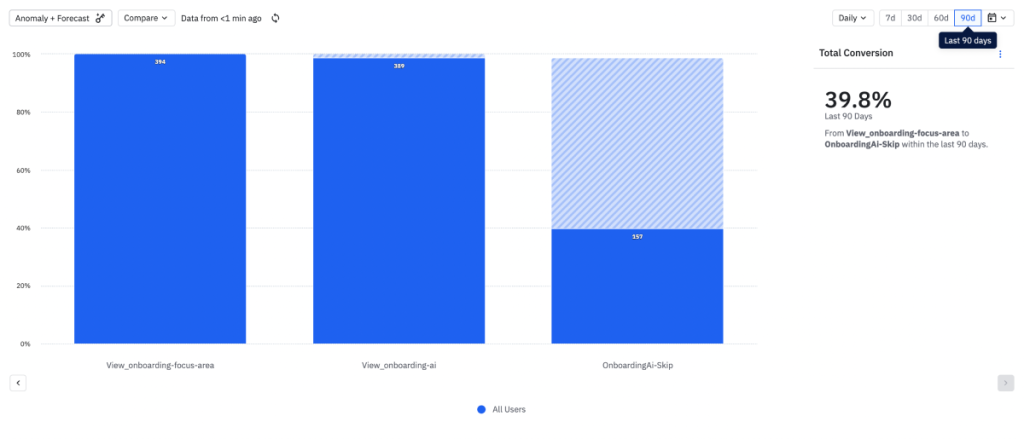
Considerable % of users skip onboarding
39.8% users chose to interact with the skip button in the onboarding flow when they found it. From the initial app analysis we knew this button is hidden and decided to investigate the onboarding flow further to understand the user behaviour and reason for skipping.
Fewer % of users interacting with Binaural beats
Only 10.8% users interact with binaural beats. The transition of users from opening the app to viewing Binaural beats to tapping it to add it to an affirmation sees a drastic drop and was worth exploring through eye-tracking.
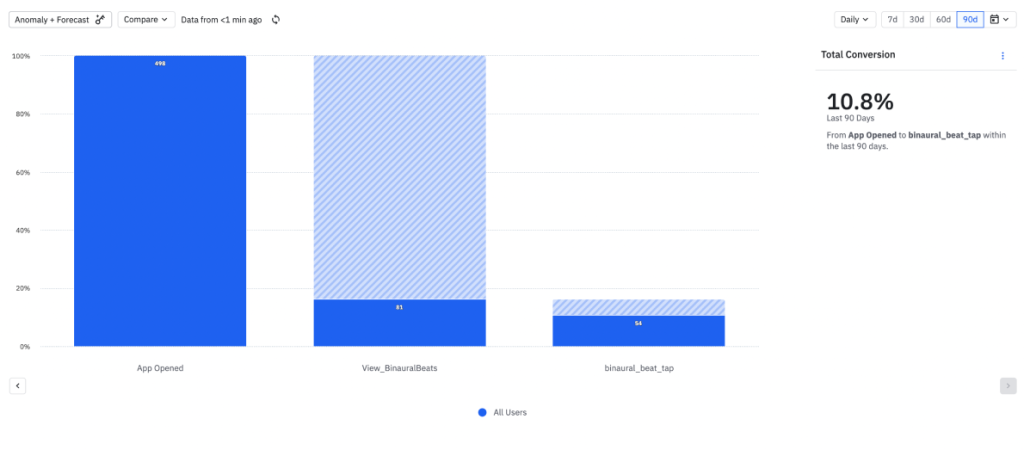
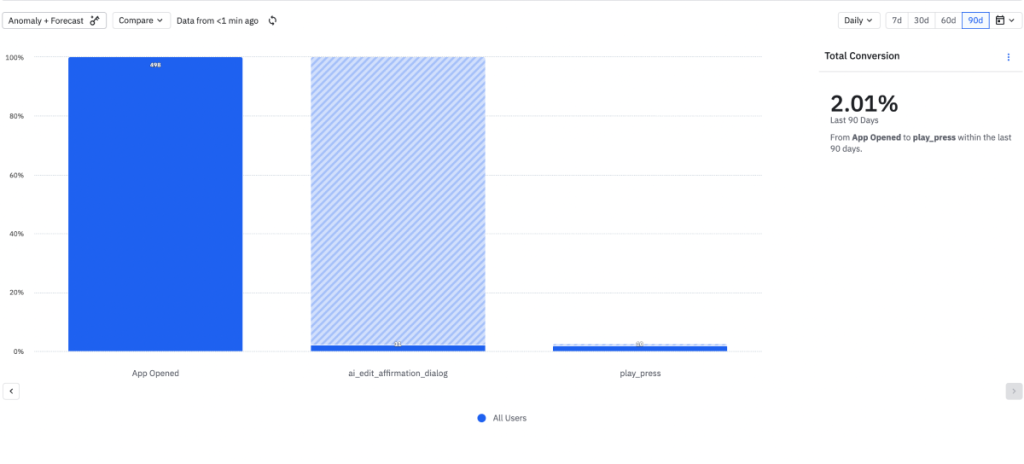
Hardly any users interact with the AI
Barely 2.01% of users choose to interact with AI bot post onboarding. The transition of users from opening the app to changing the affirmation using AI sees a drastic drop in numbers. We wanted to understand why the interaction with this feature was at a minimal level.
Choosing tasks to add context to our data story
The data observed from app usage, the amplitude and Mixpanel dashboards told a part of the story that helped define our research goals. We wanted to probe further and find explanations to our hypothesis. The tasks for our Phase 2 of the research which was the eye-tracking study was designed to answer the very questions that the data observations indicated.

Finding the PMF blockers and addressing them
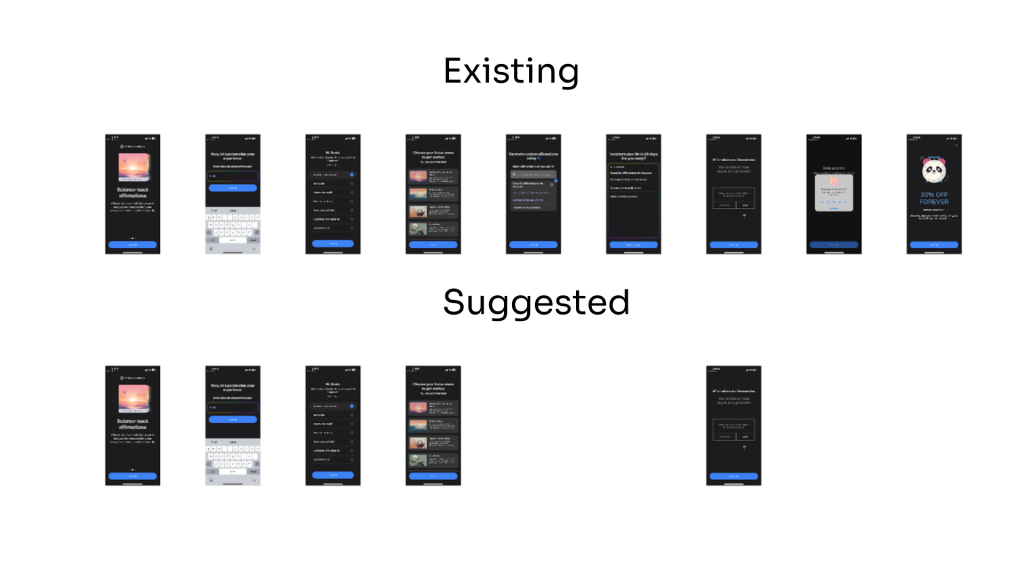
8/8 users want a shorter onboarding to keep the initial excitement going
All 8 eye-testing participants in the post-task interview indicated that the onboarding was too long and steps like “Choose focus area” were repetitive. They also felt asking for premium subscription or app feedback in onboarding was too early to expect action. The spread of the heatmaps and the focus on the close/ skip button further corroborated this finding.

” I felt like the app kept me asking the focus area question repetitively, I really wanted to get to using the app”
– P2
6/8 users were confused with the binaural beats existing in different places
Participants found binaural beats difficult to find. Even the 6 who did find it, clicked on audio customisation first before finding binaural beats. The heatmaps of the audio customisation page vs binaural beats showcases the lack of interaction with the latter.

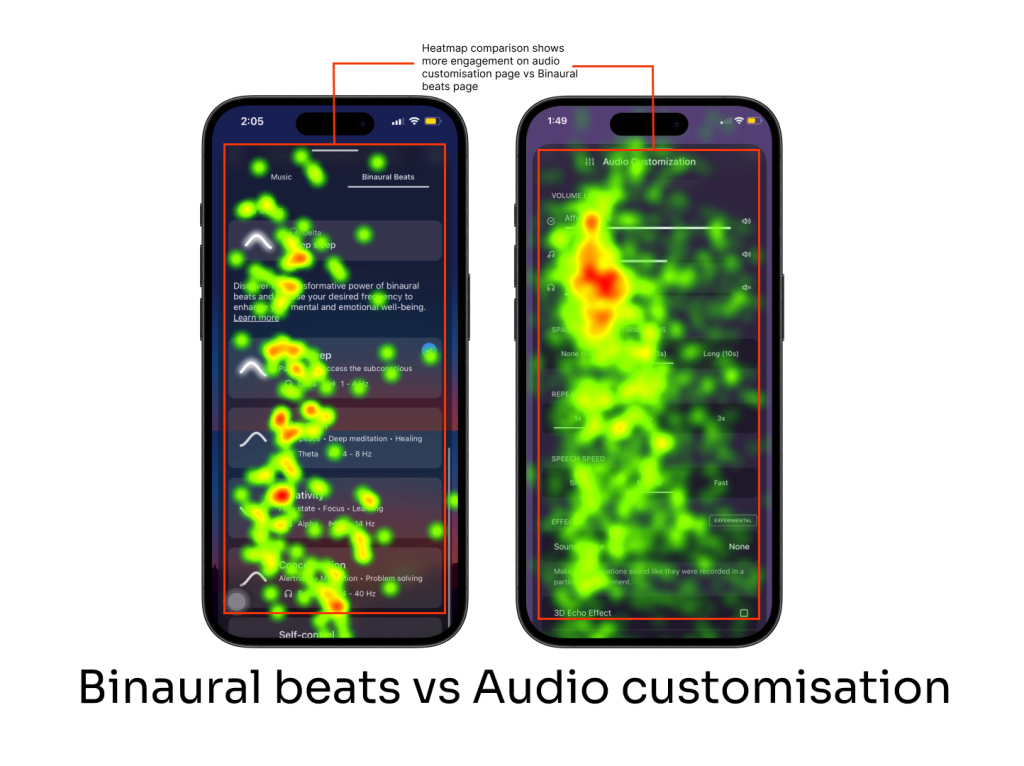
” The customisation icon at the bottom threw me off. I expected to find all audio changes there.”
-P5

7/8 users couldn’t find the AI to use it and generate affirmations
All participants while excited by the possibility of using AI to generate affirmations couldn’t find the AI. Many asserted that they thought the “Mommy” and “Eve” were social profiles. The gazeplots and the concentration of the movement on top further confirms that despite scanning all profiles participants didn’t know that “Eve” was the AI that could generate affirmations.
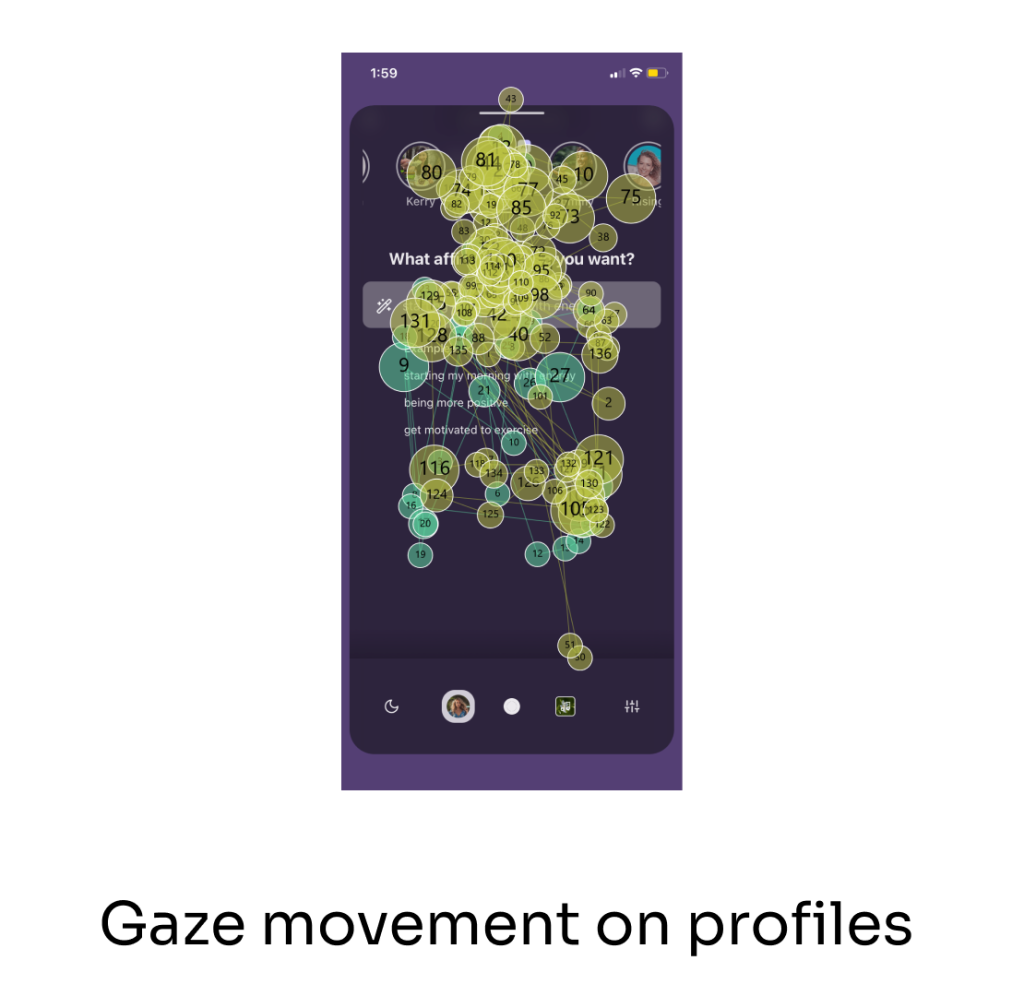
” The profiles on top looked like they might be people I follow, I was confused for a second because I didn’t remember following anyone during the onboarding. “
– P4
Substantiating Findings and giving Affirmations studio a scale to measure progress

The analysis of the eye-tracking study and the RTA’s helped confirm the hypothesis that the Mixpanel and Amplitude data dashboards had suggested. To further solidify our research we conducted a survey to understand and calculate the system usability. The System usability is at 50.9% which is 17.4% below the acceptable score ( 68% ) of other mobile interfaces. This means that the app requires major UX changes to be at the industry benchmark of 68%. Further the efficiency score which was the task completion rate amongst participants and the Effectiveness score which was the percentage of users that struggled to complete the tasks amongst the ones who completed it further solidified the need for a usability intervention.
Sharing our roadmap to PMF with Affirmations Studio
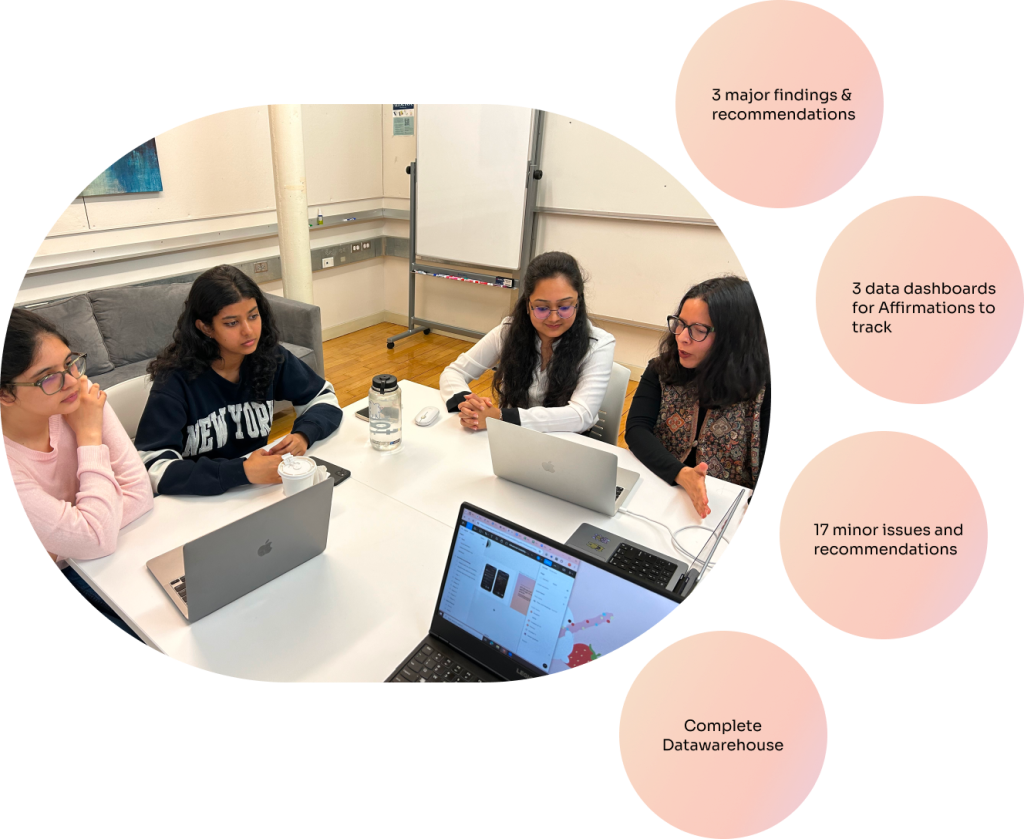
” We loved the structure of your presentation report, it was easy to follow and understand why we need to do this”
Kerry & Nick
We culminated the project by sharing 3 major and actionable findings with Affirmations studio. The changes we recommended would help Affirmations studio with better conversion and engagement on the app. We also felt that the impact of these changes could be continually tracked by the data dashboards that we created and shared the same with the client. Additionally a more detailed problem and recommendation list, Participant data of recordings, gazeplots and heatmaps were also shared with the client.
Affirmations studio is a great app and the users definitely see value in their features like AI generated Affirmations and Binaural beats once they find them. Continual efforts to improve its usability can definitely help them make a mark in the market. The biggest takeaway at the culmination of this project has been finding the story that the data is trying to tell. Reading through numbers, predicting trends and hypothesis and further using qualitative methods to double down on the research has been the biggest learning in Mixed Methods research for me.